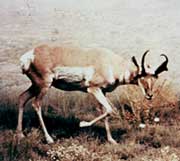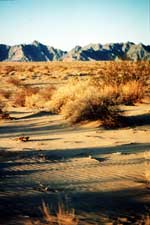As parks and forests in the West get overrun by tourists who love too much, the millions of acres controlled by the Department of Defense are suddenly looking sexier. In the Sonoran desert, for example, the last best place is a bombing range. It is a sign of the times that the 2.7 million-acre Barry M. Goldwater Bombing Range is now being fought over by conservationists, off-roaders, hunters, and a host of federal agencies.
Forget about comparisons to puny East Coast states like Rhode Island. The Goldwater Range is the size of a country, or maybe a small continent. Protected by its inhospitable name and even less hospitable climate, this is the Sonoran Desert’s last resort, a refugia for the endangered Sonoran pronghorn antelope, the flat-tailed horned lizard, the acuna cactus, and reportedly, the decomposing bones of the late, great writer Edward Abbey, who called this place “graduate school for desert rats.”

Sonoran pronghorn.
It’s also home to things that are equally endangered in the fast-growing Sunbelt these days: empty sky and unbroken horizon. You can get lost there. You can die.
We like it that way.
The Air Force has controlled the range for more than three decades. Recently, it has promoted a kinder, gentler image by hiring nationally recognized biologists and archeologists. But many of these scientists are now disappointed at what seems to be military arrogance-as-usual.
In testimony on Capitol Hill, Air Force officials asked to be exempted from formal environmental review for an unlimited period, vehemently opposed a proposal to include the bombing range in a national biological preserve, and proposed ceding the range’s most biologically significant tract of land to the U.S. Bureau of Land Management, an agency that understands cattle better than wildlife.

Mohawk Dunes,
Goldwater Bombing Range.
Sources close to the issue say that the Air Force made a backroom deal over the protests of its own local brass to give the Goldwater range’s Area A — 90,000 acres especially prized by biologists — to the Bureau of Land Management for the right to conduct military training on a national wildlife refuge in Nevada. Even more damaging were charges that the deal was made before the public comment period required by the National Environmental Policy Act ended last fall — a violation of the law, not to mention a betrayal of the trust that the Air Force has built up in the region.
Air Force officials are also offering to hand over the management of the range’s western half to the U.S. Marine Corps, which is not known for its sensitivity to the needs of Ajo lilies and endangered peregrine falcons.
Colonel Fred Pease of the Air Force admitted that negotiations are underway with the Department of Interior over the right to conduct military training over Nevada’s Desert Range, but denied that any deals were made before the public had a chance to comment.
Whatever the timing, the bottom line is that the Air Force is giving lip service to popular notions of environmental accountability and local input while sacrificing something much more important: the Goldwater Range itself.
The Air Force is also fighting a proposal by a visionary group of desert rats, including well-known authors Charles Bowden and Ann Zwinger, to establish a Sonoran Desert National Preserve. This plan would create a common management team for the Goldwater Range, Organ Pipe Cactus National Monument, and the Cabeza Prieta National Wildlife Refuge, helping species like the endangered Sonoran pronghorn, whose recovery has been hampered by the different agendas of the 27 agencies with jurisdiction over its habitat. In this case, that’s 6 million acres of open country dotted by small towns and the occasional bomb crater.
Which brings up an important point: Military training would continue in the proposed preserve, as would hunting. The only changes would be that managers could keep better track of tourism — which is growing along with the explosive growth in Arizona’s population — and work more efficiently to preserve endangered species.
This is a win-win situation for Republican Arizona Sen. John McCain, who is bucking for an environmental halo in his pursuit of the presidency, but has yet to endorse the idea. And it’s exactly the kind of big picture thinking that biologists say we need to keep natural systems in working order.
A bombing range may not be everyone’s New West fantasy, that elusive Last Best Place. But guess what? Those places are either overgrazed into dust bowls or overrun by espresso joints.
So you can call the Goldwater range something else: The Last Place.


